As we enter the era of customer-led marketing strategies, SaaS demand generation can sometimes get a bad wrap. But just because we need to be looking at the traditional funnel in a more holistic way doesn’t mean the TOFU tactics of demand gen don’t still have value.
To be clear, when we say TOFU we mean Top of Funnel campaigns that Demand Generation strategies often focus on. Lead generation, on other hand, may focus more on the bottom of the funnel, or BOFU.
For the purposes of this post we’ll be focusing on Demand Gen strategies that fall under the below definition of the B2B marketing practice.

We’ll be walking through everything you need to know about demand generation in the customer-led world of SaaS marketing. This way, you can better align your demand gen strategies towards generating actual customers instead of boosting legacy metrics like MQLs.
What Is B2B Demand Generation?
As we showed you in the graphic, Demand Generation is the focus of targeted marketing programs to drive awareness and interest in a company’s products and/or services.
Especially in a highly technical and equally saturated market like SaaS, not everyone knows what you’re selling. With the countless different software solutions being offered today – each for unique solutions to specific pain points – you need to make sure that your audience is aware of their need for your brand.
This is where Demand Generation strategies drive their value – creating the awareness, visibility, and need for your SaaS brand.
Given that the SaaS industry focuses on a tech savvy, digitally-versed market, it’s no surprise that digital demand gen marketing comes with such appeal. However, what most demand gen marketers fail to account for when partnering with SaaS clients is the unique buyer’s cycle that comes with their advanced clientele.
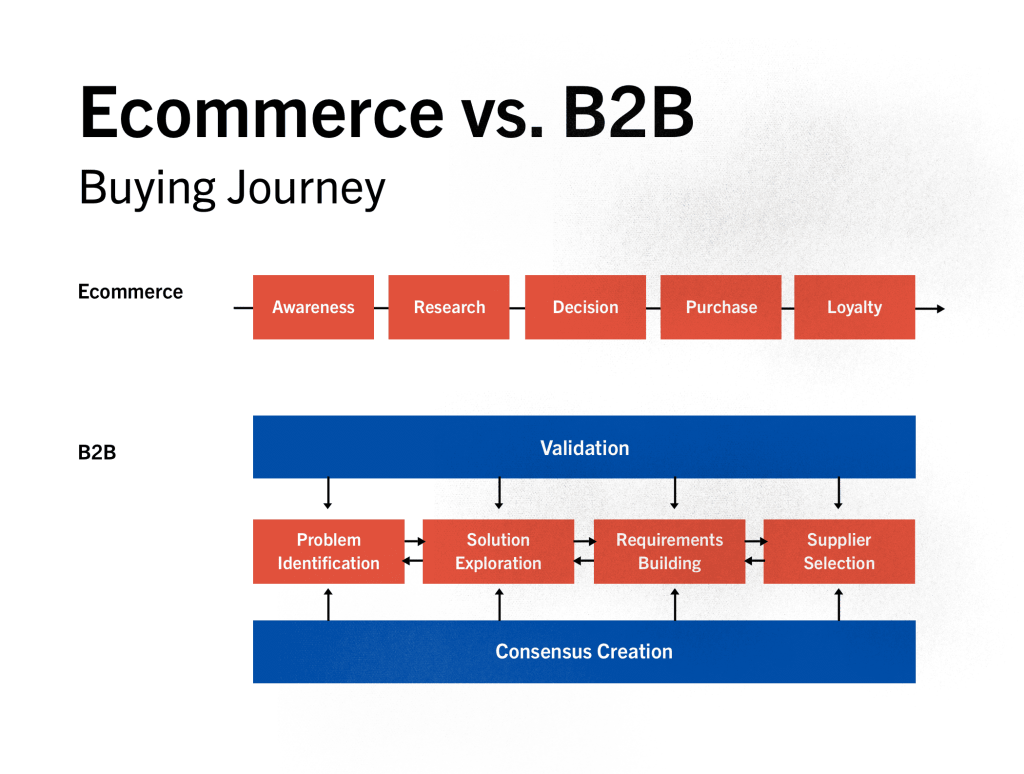
As opposed to more traditional buying cycles like the eCommerce example above, the B2B buyer’s journey can be a bit more complex. Even though they’re both digitally heavy marketing verticals, SaaS and eCommerce marketers have radically differing approaches.
With all the different touch points in the vastly complex buyer’s journey of a given SaaS campaign, there’s no wonder things can get a little muddled. And this is where most demand gen strategies fall short.
In order to (attempt to) attribute value to all these different cost-per-X campaigns, demand gen strategies created the Marketing Qualified Lead (MQL) to mark a successfully engaged prospect within this overlapping marketing funnel. And for years, SaaS marketers have been chasing the MQL trying to scale their business.
But here’s the thing. MQLs don’t actually translate into revenue. SQLs and customers do.
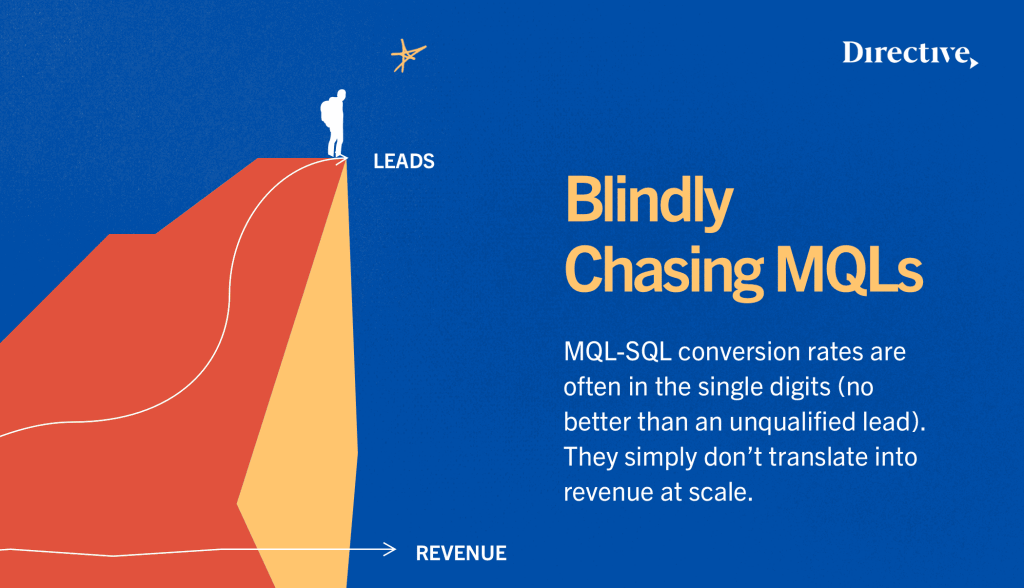
Thankfully, a new marketing methodology is emerging that helps to realign your demand generation strategies: Customer Generation.
What Is Customer Generation?
This is the primary issue that plagues all Demand Generation strategies – disparate, misaligned campaigns that fail to deliver on the promise of generating actual revenue. Instead, demand generation often results in campaigns that generate strong engagement and lead gen metrics without growing the bottom line.
Customer Generation – as the name implies – is a marketing methodology that delivers on the promise that Demand Gen forgot about. While demand generation strategies prioritize MQLs and then have you cross your fingers for an increase in revenue, Customer Generation aligns your marketing and sales, your NSMs, and your strategies towards what really matters: customers.
After all, your lead list doesn’t pay the light bills. Your customers do.
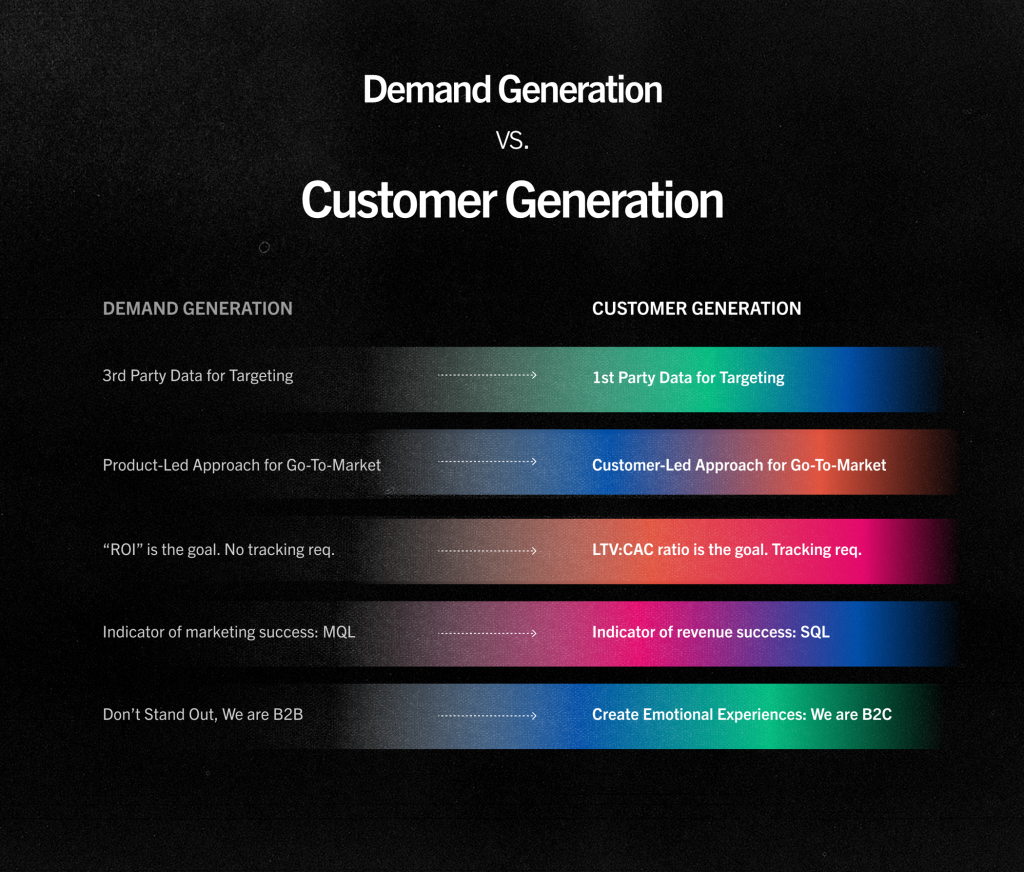
If you want to learn more about more customer-led marketing strategies, you can read more on our Customer Generation guide.
Society – Directive’s Customer Generation Community
Why Utilize B2B Demand Generation Tactics In Your Marketing Strategy?
If you’re wondering why exactly you should even know what Demand Generation is, you need look no further than Gartner:
“A strong Demand Gen strategy builds brand awareness and authority, and produces thoughtful, engaging content that drives interest and cultivates leads.”
– Gartner
As we mentioned earlier, it’s vital that you can drive awareness for your client’s need for your product. It doesn’t matter what pain point you solving and how well you’re solving it if none of your audience is aware of the problem to begin with.
This is where some demand gen agencies tend to overcorrect. It’s important to drive awareness and authority for your brand, yes. But it’s also important to be realistic about who you’re trying to reach. As opposed to what most agencies will tell you, your product/software isn’t for everyone online.

Knowing what makes your ideal end buyer truly your ideal will help you better tailor your messaging and offer to what they’re really looking for at the end of the day. And the better you know who you’re actually trying to convince to buy, the better you’ll be able to customize your marketing strategies to their unique pain points.
This means that instead of dumping all the paid media and organic leads you can possibly collect into your marketing funnel and crossing your fingers will no longer work.
It may be a rough look in the mirror, but developing an actual TAM list (total addressable market) of your ideal accounts will guarantee that each penny spent is dedicated to a potential prospect.
Customer-led alignments such as these are what can make all the difference in your SaaS demand generation strategies. If you don’t believe us, just take a look at the performance difference in the example below.
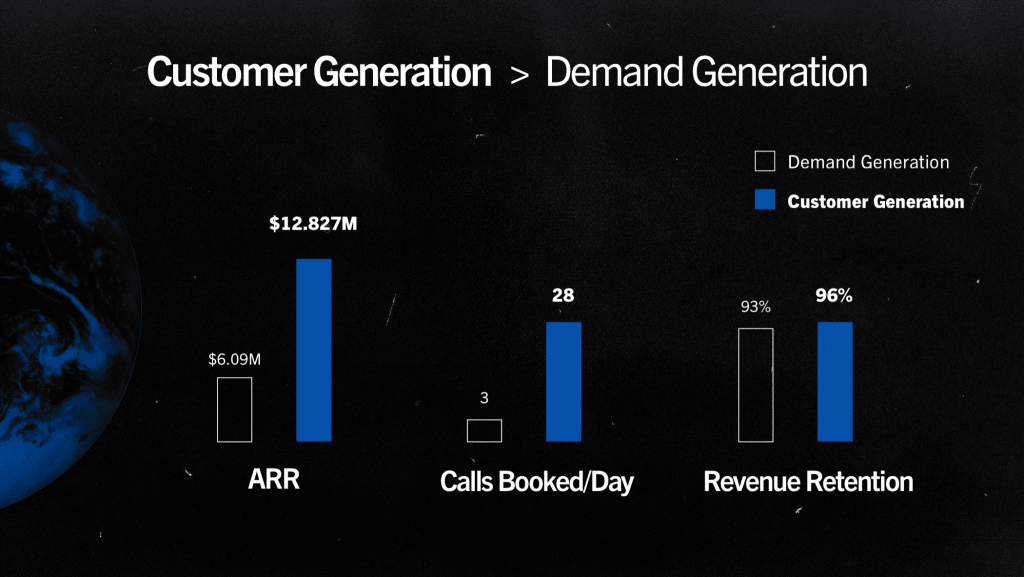
Knowing what customers are worth reaching can make all the difference in crafting demand generation strategies that create actual growth for your sales pipeline. As opposed to just annoying your reps with useless leads.
What Marketing Strategies Are A Part Of B2B Demand Generation?
Because Demand Generation is still a vital practice within the greater marketing methodology of Customer Generation, we want to keep you informed with traditional strategies that still run the test of time.
Keep in mind, however, that these strategies only work when properly aligned towards SQLs and customers. Needlessly chasing MQLs simply doesn’t solve the issues of traditional Demand Generation.
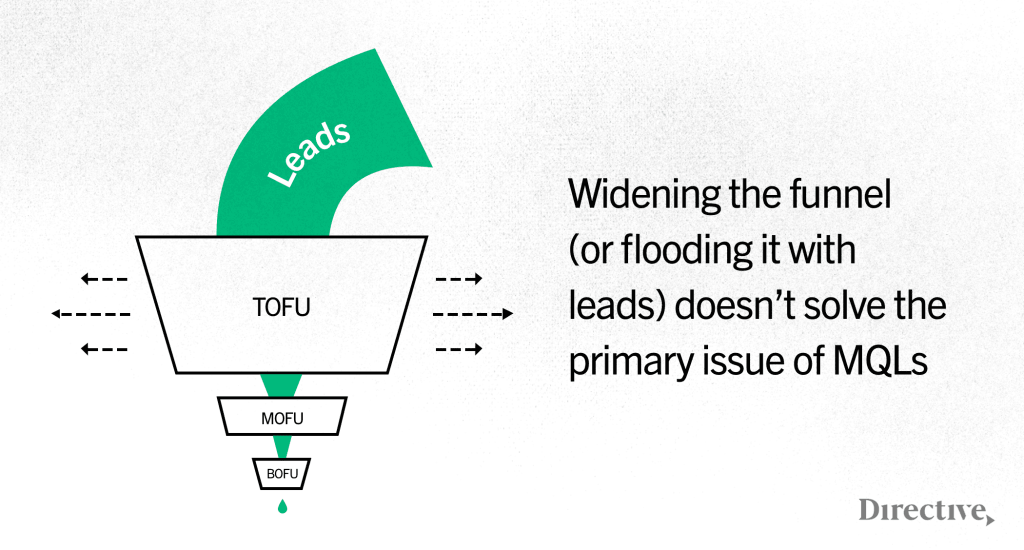
Strategy #1 Brand Advertising
Brand advertising and brand building strategies like traditional TV or CTV ads and endorsements – as well as traditional branded campaign PPC strategies – help build the authority of your brand. You want to create a ubiquitous sense of your brand and your end customer’s ideal solution.
Strategy #2 Thought Leadership
Thought leadership like guest posting or speaking events helps develop the sense of expertise around your brand’s service as well as widens your marketing network to interact with more potential prospects in an engaged environment.
Strategy #3 Social Proof/Validation
Social Proof – whether it be via review sites or from testimonials and case studies on your site, develops a sense of trust with your brand that can lower friction later on in the conversion process. There’s a good reason behind Social Proof finding its way into every facet of the marketing funnel.
Strategy #4 SEO/Content Marketing
Organic traffic generation via valuable content and insightful keyword targeting can help expose your brand to your end customers at the perfect time in the research phase. It can take time to see results, but providing useful information and valuable insights to your customers is rarely a wasted investment.
Strategy #5 Event Marketing & Sponsorships
Sponsorships and Event Marketing (either hosting, co-hosting, or speaking) helps align your brand with larger, more well-known brands that help bolster your authority and expertise. Especially if you’re changing things up with a new methodology or software, this is a great way to generate exposure for your new offering.
So why are each of these strategies uniquely important to SaaS marketing? Because with the non-physical nature of software, your end customers have a unique window into comparison shopping that product-based transactions don’t offer.
SaaS buyer’s have an incredibly extended B2B sales cycle because their consideration phase is so nuanced and complex – filled with different POCs within the same account and different value props for each.

How To Use B2B Demand Generation For Your SaaS Company
Knowing what types of strategies fall under the demand generation umbrella is one thing. Knowing how to execute them in a way that drives legitimate growth? Well, that’s another.
Thankfully, we’ve done most of the leg work for you. If you’re looking to expand your expertise on specific demand generation strategies, you can choose from the list below to get started.
And don’t worry – this is only the tip of the iceberg.
What Are The KPIs For B2B Demand Generation
There are quite a few different KPIs that demand generation strategies often focus on.
Having so many disparate campaigns is often reflected in disparate KPIs and NSMs (north star metrics).
Knowing that there are so many different types of demand generation strategies to choose from, it should come as no surprise that there’s quite a few NSMs that demand gen marketers often find themselves chasing. Even if the idea of multiple north stars seems a bit oxymoronic.
You can find a list of the most common (and often cited as most vital) demand generation KPIs and NSMs below.
- Cost Per Impression
- Cost Per Lead
- Cost Per MQL
- Conversion Rate By Channel
- Average Order Value
- Average Customer Lifecycle
What you’ll notice is many of these metrics are cost-per-xxx campaigns that focus on generating leads on the terms of the platform itself. You’re stuck trying to perform as best you can (in Google Ads) or (in CTV) instead of trying to leverage each strategy as a different step in the buyer’s journey.
If only there were a metric that allowed you to see what value each interaction was driving at each stage of the marketing funnel…

Enter the LTV:CAC formula – the backbone of Customer Generation and the truest calculator of value for any SaaS demand gen strategy.
LTV/CAC is a formula that calculates the LifeTime Value of your user (or any different marketing action) in relation to the Customer Acquisition Cost (or base costs) of that action. Based on your LTV:CAC ratio, you can see where your campaigns are generating statistically significant growth, and where your seemingly strong performance is actually costing you money.

You can learn more about LTV:CAC by reading (or viewing) the resources below. But what you really need to know is that keeping your LTV:CAC ratio above a 3:1 is the golden ratio that you should use as a baseline for success.
“If a demand generation strategy is driving 3X times the value that it’s costing, you can consider it helping you grow. Anything lower and you’re probably losing money, regardless of how strong the performance metrics may look.”
Demand Generation vs. B2C Customer Generation
The difference between B2B Demand Generation and B2C Customer Generation is the customer-led approach. At the heart of each campaign we remember that we’re reaching out to a human on the other end of each channel. We don’t want to distance ourselves with sterile, forgettable B2B branding.
You know the types we’re talking about…
You might need some reminding, but:
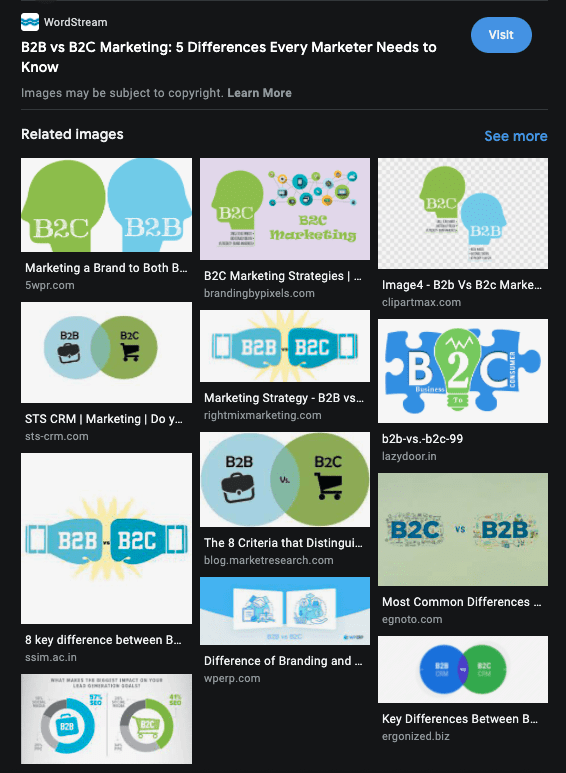
“Your customers are people, not corporations. They hate boring marketing as much as you do, we promise.”
Instead – start crafting emotional experiences that speak to your customers (as in B2C) in a memorable and remarkable way.
Customer Generation > B2B Demand Generation
The verdict is in, while demand generation does still hold a lot of value for SaaS companies, Customer generation is the preferred methodology when looking to scale and grow a company with confidence. And that’s what we all want as SaaS marketing leaders, isn’t it?
“Scaling With Confidence.” What a magical dream that would be, right?
In a world of complex twists and turns such as today’s SaaS buyer’s journey, it’s easy to get lost in the weeds chasing the wrong metrics. Keeping your eyes focused on what matters at the end of the day – reaching more customers in order to help more customers – is all that’s missing from your demand gen strategies driving the value you want to see.
Learn more about our customer generation methodology and join Society today to gain access to exclusive content on Directive’s customer-led approach to SaaS marketing.
Society – Directive’s Customer Generation Community